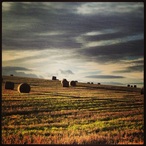|
Autumn
Autumn is the start of the shepherding year for us. We have considered which tups we need to put to which group of ewes and this is a complicated business, involving swapping tups and buying them at sales or privately.
Before the tups are put out, they need to be fit and healthy, with sound feet and healthy 'man-parts'. The ewes also need to be in good condition (well-fed but not fat) with good feet. The ewes may be sponged (a mucky job!) in advance of tupping to ensure that they all come into season at the same time. The reduces the amount of time that the tup has to spend in with the ewes and means that we can predict our lambing dates more accurately. |
WinterWinter can be hard work and much depends on the weather. A long wet winter can be miserable for sheep and shepherd alike, and long periods of snow are not uncommon.
All the sheep get a vitamin drench to keep them healthy and ensure that they get the best out of their feeding. Once the tups have been removed, they spend the rest of the winter with their male pals, generally just eating and fighting. General jobs include checking their feet, guarding against parasites such as liver fluke or infections such as pink-eye. The ewes also need protecting from these problems and need special care to ensure that they get the right amount of nutrition for themselves and their unborn lambs. Once winter sets in, all the sheep have access to ad-lib hay, as well as mineral buckets and hard feed in troughs. |
SpringSpring used to mean lambing for us - and it was always the hardest working part of the year.
In 2018 we decided that we would become solely a wool flock. Lambing inevitably means the production of tup lambs (boys). The choices available then are to castrate or wether the tups by banding versus keeping 'entire', then: - grow them on and slaughter for meat (wethered or entire) - grow them on (wethered or entire) and sell at market (in which case they *will* be bought by meat-dealers) - keep within the flock for wool-production (wethered) After a lot of thought (and the unexpected loss of the park that we had always used to keep our tups on), we decided to stop lambing and just keep a wool flock - predominantly female - and buy in replacements as needed. This was a wrench! Lambing has always been a key part of our shepherding year. However, it does mean that we can legitimately say that we keep a slaughter-free flock. |
SummerSummer means tending to the lambs, and visiting shows to see other breeders' sheep.
Raising lambs takes a lot out of the ewes and they need access to feed (best of all is good grass). New grass means we need to avoid worms in the sheep and the lambs. Warm weather brings the worry of fly-strike and, as we do not dip the sheep or dose them before shearing, it is a worrying time. Shearing usually happens mid-June into July (again depending on the weather as we have no shelter to keep the sheep dry) and we rely on friends to help us catch sheep and roll fleeces. The lambs are spained in August and it is a noisy time! We move the ewes several miles away from their lambs to make this easier. June to August is also 'show season' and much time is taken to prepare sheep for sales. |
Proudly powered by Weebly




